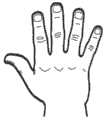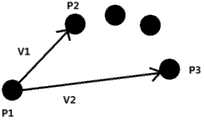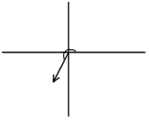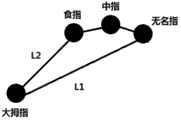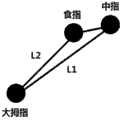CN103294268A - Human left-right hand identification method on multi-point touch screen - Google Patents
Human left-right hand identification method on multi-point touch screenDownload PDFInfo
- Publication number
- CN103294268A CN103294268ACN2013102099411ACN201310209941ACN103294268ACN 103294268 ACN103294268 ACN 103294268ACN 2013102099411 ACN2013102099411 ACN 2013102099411ACN 201310209941 ACN201310209941 ACN 201310209941ACN 103294268 ACN103294268 ACN 103294268A
- Authority
- CN
- China
- Prior art keywords
- hand
- point
- finger
- thumb
- recognition
- Prior art date
- Legal status (The legal status is an assumption and is not a legal conclusion. Google has not performed a legal analysis and makes no representation as to the accuracy of the status listed.)
- Granted
Links
Images
Landscapes
- Position Input By Displaying (AREA)
Abstract
Translated fromChineseDescription
Translated fromChinese技术领域technical field
本发明涉及一种计算机识别人类左右手的方法,具体地,涉及一种多点触控屏幕上的人类左右手识别方法。The invention relates to a method for computer recognition of human left and right hands, in particular to a method for recognizing human left and right hands on a multi-touch screen.
背景技术Background technique
随着技术的反战,触控技术越来越普及,比如支持触摸屏的手机、MP3、数码相机、医院、图书馆等设置的触控电脑等。但是这些已经存在的触控幕都是单点触控,只能识别和支持每次一个手指的触控、点击,若同时有两个以上的点被触碰,就不能做出正确反应,而多点触控技术能把任务分解为两个方面的工作,一是同时采集多点信号,二是对每路信号的意义进行判断,也就是所谓的手势识别,从而实现屏幕识别人的五个手指同时做的点击、触控动作。With the anti-war technology, touch technology is becoming more and more popular, such as mobile phones that support touch screens, MP3, digital cameras, touch computers installed in hospitals, libraries, etc. However, these existing touch screens are all single-point touch, which can only recognize and support the touch and click of one finger at a time. If more than two points are touched at the same time, they cannot make a correct response. Multi-touch technology can decompose the task into two aspects of work, one is to collect multi-point signals at the same time, and the other is to judge the meaning of each signal, which is the so-called gesture recognition, so as to realize the five functions of screen recognition. Simultaneous click and touch actions performed by fingers.
多点触控是采用人机交互技术与硬件设备共同实现的技术,能在没有传统输入设备(如:鼠标、键盘等)下进行计算机的人机交互操作。用户可通过双手进行单点触摸,也可以以单击、双击、平移、按压、滚动以及旋转等不同手势触摸屏幕,实现随心所欲地操控。为了让使用者有更好的体验,有时候需要设置左、右手习惯的个性化交互。Multi-touch is a technology realized jointly by human-computer interaction technology and hardware equipment, and can perform human-computer interaction operations on computers without traditional input devices (such as: mouse, keyboard, etc.). Users can perform a single touch with both hands, or touch the screen with different gestures such as single-click, double-click, pan, press, scroll, and rotate to achieve arbitrary manipulation. In order to allow users to have a better experience, sometimes it is necessary to set up personalized interactions for left and right hands.
现在技术中,也有一些左右手识别方法,比如中国专利公开号为102799268A的发明专利,该专利公开“一种手持终端左右手识别方法,利用手持终端内置偏转角度传感器,包括以下步骤:101)检测并获取用户操控手持终端时的偏转角度;102)根据所述偏转角度与设定的角度门限比较识别左手或右手并累计计数;103)重复步骤101-102),若所述累计计数超过设定的对应计数门限,识别并输出左手操控或右手操控。这种识别方法,简单快捷且识别精度高,从而能为左/右手习惯分别设置个性化交互,最大地满足了不同人群的需求。”In the current technology, there are also some left and right hand identification methods, such as the invention patent of Chinese Patent Publication No. 102799268A, which discloses "a method for identifying left and right hands of a handheld terminal, using the built-in deflection angle sensor of the handheld terminal, including the following steps: 101) Detect and acquire The deflection angle when the user manipulates the handheld terminal; 102) compare and identify the left hand or right hand according to the deflection angle and the set angle threshold and count cumulatively; 103) repeat steps 101-102), if the cumulative count exceeds the set corresponding Count the threshold, identify and output left-handed or right-handed control. This recognition method is simple, fast and has high recognition accuracy, so that personalized interactions can be set for left/right-handed habits, which can meet the needs of different groups of people to the greatest extent.”
又如公开号为102289301A的发明专利,该发明涉及一种可自由切换左右手操作模式的鼠标,“该鼠标包括侦测单元及处理单元。该侦测单元用于侦测操作该鼠标的手是左手还是右手,该处理单元在该侦测单元侦测到操作该鼠标的手为左手或为右手时产生相应的左手识别信号或右手识别信号。该左手识别信号用于将当前操作模式变更为左手操作模式,该右手识别信号用于将当前操作模式变更为右手操作模式。所述鼠标,通过设置侦测单元识别操作该鼠标的手是左手还是右手,从而作相应的左右手操作模式的变更,实现鼠标左右手操作模式的自由切换,操作简便。”Another example is the invention patent with publication number 102289301A, which relates to a mouse that can freely switch between left and right handed operation modes. "The mouse includes a detection unit and a processing unit. The detection unit is used to detect whether the hand operating the mouse is left-handed Or the right hand, the processing unit generates a corresponding left-hand identification signal or a right-hand identification signal when the detection unit detects that the hand that operates the mouse is left-handed or right-handed. The left-hand identification signal is used to change the current operating mode to left-handed operation mode, the right-hand identification signal is used to change the current operating mode to the right-hand operating mode. The mouse, by setting the detection unit to identify whether the hand operating the mouse is left-handed or right-handed, thereby making corresponding changes in the left-handed and right-handed operating modes, realizing the mouse Free switching between left and right hand operation modes, easy to operate.”
以上方法虽然可以识别不同情况下的左右手,但是无法适用于多点触控屏幕上的左右手识别。目前虽然有多点触控屏幕上手势识别的报道,但是还没有发现用于多点触控屏幕上的人类左右手识别方法。Although the above method can identify the left and right hands in different situations, it cannot be applied to the left and right hand recognition on the multi-touch screen. Although there are reports on gesture recognition on multi-touch screens, no method for human left and right hand recognition on multi-touch screens has been found yet.
发明内容Contents of the invention
针对现有技术中的缺陷,本发明的目的是提供一种多点触控屏幕上的人类左右手识别方法,该方法根据手指在屏幕上的触摸点的相互之间的相对位置进行计算分析,最后得出是左手还是右手。Aiming at the defects in the prior art, the object of the present invention is to provide a method for identifying human left and right hands on a multi-touch screen, which calculates and analyzes according to the relative positions of the touch points of the fingers on the screen, and finally Find out if it's left or right handed.
为实现上述目的,本发明所述多点触控屏幕上的人类左右手识别方法,包括静态识别和动态识别,其中静态识别用于识别静止状态下或者在某一瞬间,屏幕上的手是左手还是右手;动态识别用于手在运动中的识别;具体使用时可以使用静态识别或者静态识别和动态识别结合的方式。In order to achieve the above object, the human left and right hand recognition method on the multi-touch screen of the present invention includes static recognition and dynamic recognition, wherein the static recognition is used to recognize whether the hand on the screen is left or right in a static state or at a certain moment. Right hand; dynamic recognition is used to recognize the hand in motion; in specific use, static recognition or a combination of static recognition and dynamic recognition can be used.
具体的,所述静态识别包括如下步骤:Specifically, the static identification includes the following steps:
第一步,人手在多点触控屏幕上触摸后,会有对应手指的五个触摸点,找到该五个触摸点形成的凸五边形。In the first step, after the human hand touches the multi-touch screen, there will be five touch points corresponding to the fingers, and a convex pentagon formed by the five touch points is found.
将五个触摸点两两相连,形成一个由10条线段所形成的图。寻找该图中的总长度最短的汉密尔顿回路,该回路就是由五个触摸点所形成的的凸五边形。汉密尔顿回路是经过每个点一次且仅一次的回路。Connect five touch points two by two to form a graph formed by 10 line segments. Find the Hamiltonian circuit with the shortest total length in the graph, which is a convex pentagon formed by five touch points. A Hamiltonian circuit is a circuit that goes through each point once and only once.
第二步,根据凸五边形找到五个触摸点所对应的手指。The second step is to find the fingers corresponding to the five touch points according to the convex pentagon.
在第一步找到的凸五边形中,最长边L1由大拇指和小指连接而成,第二长边L2由大拇指和食指连接而成。两条边共同拥有的点即为大拇指所对应的点。最长边L1的另一个点即为小指所对应的的点,第二长边L2的另一个点即为食指所对应的点。由于食指与中指相邻,无名指与小指相邻,由此可以找到中指和无名指所对应的点。In the convex pentagon found in the first step, the longest side L1 is formed by connecting the thumb and little finger, and the second longest side L2 is formed by connecting the thumb and index finger. The point shared by the two sides is the point corresponding to the thumb. Another point on the longest side L1 is the point corresponding to the little finger, and another point on the second longest side L2 is the point corresponding to the index finger. Since the index finger is adjacent to the middle finger and the ring finger is adjacent to the little finger, the points corresponding to the middle finger and the ring finger can be found.
第三步,比较并判断由大拇指和食指组成的向量与由大拇指和小指组成的向量之间是顺时针还是逆时针的关系,并通过该顺时针、逆时针关系判断是左手还是右手。The third step is to compare and judge whether the relationship between the vector composed of the thumb and index finger and the vector composed of the thumb and little finger is clockwise or counterclockwise, and judge whether it is a left hand or a right hand based on the clockwise and counterclockwise relationship.
设大拇指为P1,食指为P2,小指为P3,则向量V1为(P1,P2),V2为(P1,P3)。将向量V1逆时针旋转,直至向量V1与向量V2重合,若旋转的角度大于等于0度小于180度,则向量V2在向量V1的逆时针方向;若旋转的角度大于180度,则向量V2在向量V1的顺时针方向。如果向量V2在向量V1的逆时针方向,则为右手;反之,则为左手。Let the thumb be P1, the index finger be P2, and the little finger be P3, then the vector V1 is (P1, P2), and the vector V2 is (P1, P3). Rotate the vector V1 counterclockwise until the vector V1 coincides with the vector V2. If the rotation angle is greater than or equal to 0 degrees and less than 180 degrees, the vector V2 is in the counterclockwise direction of the vector V1; if the rotation angle is greater than 180 degrees, the vector V2 is in the Clockwise direction of vector V1. If the vector V2 is in the counterclockwise direction of the vector V1, it is right-handed; otherwise, it is left-handed.
以上为静态识别的过程,将手的五指自然地放在触屏上并静止不动,静态识别的精确度非常高。但是如果手在运动中,比如做放大或者缩小的手势,五指的相对位置在有些时候并不会像静态的时候所想的那样。因此,需要采用动态识别的方法。动态的手势可能会出现两种导致静态识别不精确的原因:部分手指在无意中离开了屏幕和手型产生了扭曲的动作。以下是对两种情况进行了处理。The above is the process of static recognition. Put the five fingers of your hand on the touch screen naturally and keep still. The accuracy of static recognition is very high. But if the hand is in motion, such as zooming in or zooming out, the relative position of the five fingers is sometimes not as expected when it is static. Therefore, a dynamic identification method is required. Dynamic gestures may have two reasons that lead to inaccurate static recognition: some fingers leave the screen inadvertently and the hand shape produces a distorted movement. The following two cases are handled.
(1),当部分手指离开了屏幕。(1), when part of the finger leaves the screen.
如果部分手指离开了屏幕,则无法通过静态识别的方法找到凸五边形。通过观察发现,如果剩下四个手指在屏幕上,则离开屏幕的手指多为小拇指;如果剩下三个手指,则离开屏幕的手指多为小拇指和无名指。在做放大和缩小的动作中,这一现象尤为明显。If some fingers leave the screen, the convex pentagon cannot be found by static recognition. Through observation, it is found that if there are four remaining fingers on the screen, the fingers leaving the screen are mostly the little finger; if there are three fingers remaining, the fingers leaving the screen are mostly the little finger and the ring finger. This phenomenon is especially noticeable when zooming in and out.
因此,只需找到相应的凸四边形或者三角形即可。如果剩余四个手指,最长边L1改为大拇指和无名指的连线;如果剩余三个手指,最长边L1改为大拇指和中指的连线。其余方法和之前的静态识别方法一致。Therefore, it is only necessary to find the corresponding convex quadrilateral or triangle. If there are four fingers left, the longest side L1 is changed to the line connecting the thumb and the ring finger; if there are three fingers left, the longest side L1 is changed to the line connecting the thumb and the middle finger. The rest of the methods are consistent with the previous static identification method.
(2)手型产生了扭曲。(2) The shape of the hand is distorted.
在这种情况下,单纯的静态识别方法会出现不精确的情况。然而手型扭曲的情况在整个运动中出现的概率相当小。设五指触摸到屏幕的时间为t1,当前时刻为t2,在t1~t2之间,若出现右手的次数最多,则当前手为右手;若出现左手的次数最多,则当前手为左手。In this case, the purely static identification method will appear inaccurate. However, the probability of hand twisting in the whole movement is quite small. Let the time when the five fingers touch the screen be t1, and the current moment be t2. Between t1 and t2, if the right hand appears the most times, the current hand is the right hand; if the left hand appears the most times, the current hand is the left hand.
与现有技术相比,本发明具有如下的有益效果:Compared with the prior art, the present invention has the following beneficial effects:
本发明可用于触屏设备(包括平板电脑、智能手机等)以及其他可以捕捉手指的设备上,来进行左右手的识别。当前触屏设备普及率非常高,基于触屏的应用也层出不穷。某些应用可能会使用到左右手识别,以使得应用更加丰富多彩。The present invention can be used on touch-screen devices (including tablet computers, smart phones, etc.) and other devices that can capture fingers to identify left and right hands. Currently, the penetration rate of touch screen devices is very high, and applications based on touch screens emerge in endlessly. Some applications may use left and right hand recognition to make the application more colorful.
附图说明Description of drawings
通过阅读参照以下附图对非限制性实施例所作的详细描述,本发明的其它特征、目的和优点将会变得更明显:Other characteristics, objects and advantages of the present invention will become more apparent by reading the detailed description of non-limiting embodiments made with reference to the following drawings:
图1为人手示意图;Figure 1 is a schematic diagram of the human hand;
图2为人手指的五个触摸点示意图;2 is a schematic diagram of five touch points of a human finger;
图3为人手指的五个触摸点连线后示意图;Fig. 3 is a schematic diagram after connecting five touch points of a human finger;
图4为五个触摸点所形成的的凸五边形示意图;Fig. 4 is a schematic diagram of a convex pentagon formed by five touch points;
图5为五个触摸点所对应的手指示意图;FIG. 5 is a schematic diagram of fingers corresponding to five touch points;
图6为手指之间的向量比较示意图;Fig. 6 is a schematic diagram of vector comparison between fingers;
图7-图8为手指直线的倾斜角方向判断示意图;Fig. 7-Fig. 8 are schematic diagrams for judging the inclination angle direction of a straight line of a finger;
图9-图10为人手动态识别示意图;Figure 9-Figure 10 is a schematic diagram of dynamic recognition of human hands;
图11-图12为本发明仿真实例示意图。11-12 are schematic diagrams of simulation examples of the present invention.
具体实施方式Detailed ways
下面结合具体实施例对本发明进行详细说明。以下实施例将有助于本领域的技术人员进一步理解本发明,但不以任何形式限制本发明。应当指出的是,对本领域的普通技术人员来说,在不脱离本发明构思的前提下,还可以做出若干变形和改进。这些都属于本发明的保护范围。The present invention will be described in detail below in conjunction with specific embodiments. The following examples will help those skilled in the art to further understand the present invention, but do not limit the present invention in any form. It should be noted that those skilled in the art can make several modifications and improvements without departing from the concept of the present invention. These all belong to the protection scope of the present invention.
本实施例提供一种多点触控屏幕上的人类左右手识别方法。如图1所示,为一般人手的示意图。如图2所示,为人手一般在触摸屏上留下的5各触摸点。This embodiment provides a method for recognizing human left and right hands on a multi-touch screen. As shown in Figure 1, it is a schematic diagram of a general human hand. As shown in FIG. 2 , there are five touch points generally left by human hands on the touch screen.
1.找出五个触摸点所形成的凸五边形。1. Find the convex pentagon formed by the five touch points.
将五个触摸点两两相连,形成一个由10条线段所形成的的图(如图3所示)。寻找该图中的总长度最短的汉密尔顿回路,该回路就是由五个触摸点所形成的的凸五边形(图4所示)。汉密尔顿回路是经过每个点一次且仅一次的回路。Connect the five touch points two by two to form a graph formed by 10 line segments (as shown in Figure 3). Find the Hamilton circuit with the shortest total length in the graph, which is a convex pentagon formed by five touch points (as shown in Figure 4). A Hamiltonian circuit is a circuit that goes through each point once and only once.
2.找到五个触摸点所对应的手指。2. Find the fingers corresponding to the five touch points.
在之前找到的凸五边形中,最长边L1由大拇指和小指连接而成,第二长边L2由大拇指和食指连接而成。两条边共同拥有的点即为大拇指所对应的点。L1的另一个点即为小指所对应的的点,L2的另一个点即为食指所对应的点。由于食指与中指相邻,无名指与小指相邻,由此可以找到中指和无名指所对应的点(图5所示)。In the convex pentagon found before, the longest side L1 is formed by connecting the thumb and little finger, and the second longest side L2 is formed by connecting the thumb and index finger. The point shared by the two sides is the point corresponding to the thumb. The other point of L1 is the point corresponding to the little finger, and the other point of L2 is the point corresponding to the index finger. Since the index finger is adjacent to the middle finger, and the ring finger is adjacent to the little finger, the points corresponding to the middle finger and ring finger can be found (as shown in Figure 5).
3.比较由大拇指和食指组成的向量与由大拇指和小指组成的向量之间是顺时针还是逆时针的关系。3. Compare whether the vector consisting of the thumb and index finger is clockwise or counterclockwise to the vector consisting of the thumb and little finger.
设大拇指为P1,食指为P2,小指为P3,则向量V1为(P1,P2),V2为(P1,P3)。如图6所示,若将V1逆时针旋转,直至V1与V2重合。若旋转的角度大于等于0度小于180度,则V2在V1的逆时针方向;若旋转的角度大于180度,则V2在V1的顺时针方向。Let the thumb be P1, the index finger be P2, and the little finger be P3, then the vector V1 is (P1, P2), and the vector V2 is (P1, P3). As shown in Figure 6, if V1 is rotated counterclockwise until V1 coincides with V2. If the rotation angle is greater than or equal to 0 degrees and less than 180 degrees, then V2 is in the counterclockwise direction of V1; if the rotation angle is greater than 180 degrees, then V2 is in the clockwise direction of V1.
根据一般知识,直线的倾斜角为若K>=0,arctan(K);若K<0,pi-arctan(-K),K为斜率,倾斜角范围为[0,180)。在这里,定义向量V的倾斜角为将向量V顺时针旋转到x轴正方向所需要经过的角度。倾斜角的范围为[0,360)。计算该倾斜角的方法为,如果向量在一、二象限,则倾斜角是该向量所在的直线的倾斜角;如果向量在三、四象限,则倾斜角是该向量所在的倾斜角加上180度。如图7、8所示。According to general knowledge, the inclination angle of a straight line is if K>=0, arctan(K); if K<0, pi-arctan(-K), K is the slope, and the inclination angle range is [0,180). Here, the inclination angle of the vector V is defined as the angle required to rotate the vector V clockwise to the positive direction of the x-axis. The range of tilt angle is [0,360). The method of calculating the inclination angle is, if the vector is in the first and second quadrants, the inclination angle is the inclination angle of the line where the vector is located; if the vector is in the third and fourth quadrants, the inclination angle is the inclination angle where the vector is located plus 180 Spend. As shown in Figure 7 and 8.
设V1的倾斜角为A1,V2的倾斜角为A2。若A2-A1大于等于0且小于180度,或者A2-A1小于-180度,则说明V2在V1的逆时针方向;反之,则说明V2在V1的顺时针方向。Let the inclination angle of V1 be A1, and the inclination angle of V2 be A2. If A2-A1 is greater than or equal to 0 and less than 180 degrees, or A2-A1 is less than -180 degrees, it means that V2 is in the counterclockwise direction of V1; otherwise, it means that V2 is in the clockwise direction of V1.
4.如果V2在V1的逆时针方向,则为右手;反之,则为左手。4. If V2 is in the counterclockwise direction of V1, it is the right hand; otherwise, it is the left hand.
若将手的五指自然地放在触屏上并静止不动,静态识别的精确度非常高。但是如果手在运动中,比如做放大或者缩小的手势,五指的相对位置在有些时候并不会像静态的时候所想的那样。因此,必须采用动态识别的方法。If the five fingers of the hand are naturally placed on the touch screen and remain still, the accuracy of static recognition is very high. But if the hand is in motion, such as zooming in or zooming out, the relative position of the five fingers is sometimes not as expected when it is static. Therefore, a dynamic identification method must be adopted.
动态的手势可能会出现两种导致静态识别不精确的原因:部分手指在无意中离开了屏幕和手型产生了扭曲的动作。以下是对两种情况进行了处理。Dynamic gestures may have two reasons that lead to inaccurate static recognition: some fingers leave the screen inadvertently and the hand shape produces a distorted movement. The following two cases are handled.
1.部分手指离开了屏幕。1. Some fingers left the screen.
如果部分手指离开了屏幕,则无法通过静态识别的方法找到凸五边形。通过观察发现,如果剩下四个手指在屏幕上,则离开屏幕的手指多为小拇指;如果剩下三个手指,则离开屏幕的手指多为小拇指和无名指。在做放大和缩小的动作中,这一现象尤为明显。If some fingers leave the screen, the convex pentagon cannot be found by static recognition. Through observation, it is found that if there are four remaining fingers on the screen, the fingers leaving the screen are mostly the little finger; if there are three fingers remaining, the fingers leaving the screen are mostly the little finger and the ring finger. This phenomenon is especially noticeable when zooming in and out.
因此,只需找到相应的凸四边形或者三角形即可。如果剩余四个手指,最长边L1改为大拇指和无名指的连线;如果剩余三个手指,最长边L1改为大拇指和中指的连线。其余计算方法和之前的静态识别方法一致。如图9,图10所示。Therefore, it is only necessary to find the corresponding convex quadrilateral or triangle. If there are four fingers left, the longest side L1 is changed to the line connecting the thumb and the ring finger; if there are three fingers left, the longest side L1 is changed to the line connecting the thumb and the middle finger. The remaining calculation methods are consistent with the previous static identification method. As shown in Figure 9 and Figure 10.
2.手型产生了扭曲。2. The shape of the hand is distorted.
在这种情况下,单纯的静态识别方法会出现不精确的情况。然而手型扭曲的情况在整个运动中出现的概率相当小。设五指触摸到屏幕的时间为t1,当前时刻为t2,在t1~t2之间,若出现右手的次数最多,则当前手为右手;若出现左手的次数最多,则当前手为左手。In this case, the purely static identification method will appear inaccurate. However, the probability of hand twisting in the whole movement is quite small. Let the time when the five fingers touch the screen be t1, and the current moment be t2. Between t1 and t2, if the right hand appears the most times, the current hand is the right hand; if the left hand appears the most times, the current hand is the left hand.
如图11-图12所示,为仿真实例,其中大拇指和小拇指的连线,大拇指和食指的连线均符合本发明上述的原则。As shown in Figures 11-12, it is a simulation example, wherein the connection between the thumb and the little finger, and the connection between the thumb and the forefinger all conform to the above-mentioned principles of the present invention.
本发明简单且识别精度高,从而可用于触屏设备(包括平板电脑、智能手机等)以及其他可以捕捉手指的设备上,来进行左右手的识别,为左/右手人群提供相应的需求。The invention is simple and has high identification accuracy, so it can be used on touch-screen devices (including tablet computers, smart phones, etc.) and other devices that can capture fingers to identify left and right hands, and provide corresponding needs for left/right-handed people.
以上对本发明的具体实施例进行了描述。需要理解的是,本发明并不局限于上述特定实施方式,本领域技术人员可以在权利要求的范围内做出各种变形或修改,这并不影响本发明的实质内容。Specific embodiments of the present invention have been described above. It should be understood that the present invention is not limited to the specific embodiments described above, and those skilled in the art may make various changes or modifications within the scope of the claims, which do not affect the essence of the present invention.
Claims (4)
Priority Applications (1)
| Application Number | Priority Date | Filing Date | Title |
|---|---|---|---|
| CN201310209941.1ACN103294268B (en) | 2013-05-30 | Human left-right hand identification method in multi-point touch screen |
Applications Claiming Priority (1)
| Application Number | Priority Date | Filing Date | Title |
|---|---|---|---|
| CN201310209941.1ACN103294268B (en) | 2013-05-30 | Human left-right hand identification method in multi-point touch screen |
Publications (2)
| Publication Number | Publication Date |
|---|---|
| CN103294268Atrue CN103294268A (en) | 2013-09-11 |
| CN103294268B CN103294268B (en) | 2016-11-30 |
Family
ID=
Cited By (9)
| Publication number | Priority date | Publication date | Assignee | Title |
|---|---|---|---|---|
| CN104169860A (en)* | 2013-11-08 | 2014-11-26 | 华为技术有限公司 | Intelligent terminal and method used for displaying input operation interface |
| CN104932825A (en)* | 2015-06-15 | 2015-09-23 | 金陵科技学院 | Method for automatically sensing left hand/right hand to operate mobile phone and determining moving thermal region of thumb |
| CN106210242A (en)* | 2015-04-29 | 2016-12-07 | 宇龙计算机通信科技(深圳)有限公司 | Antenna switching method, device and terminal |
| CN106681629A (en)* | 2016-12-06 | 2017-05-17 | 广州视源电子科技股份有限公司 | Display mode switching method and device |
| CN108269350A (en)* | 2016-12-30 | 2018-07-10 | 航天信息股份有限公司 | The verification method and device of seal |
| CN110334561A (en)* | 2018-03-31 | 2019-10-15 | 广州卓腾科技有限公司 | A kind of gestural control method of control object rotation |
| CN112603276A (en)* | 2020-12-28 | 2021-04-06 | 中科彭州智慧产业创新中心有限公司 | Rapid detection equipment and method for pulse waves of cun and kou of both hands |
| CN112603275A (en)* | 2020-12-28 | 2021-04-06 | 中科彭州智慧产业创新中心有限公司 | Double-hand cunkou pulse wave detection equipment and method based on ultrasonic sensor |
| CN113296675A (en)* | 2021-04-26 | 2021-08-24 | 兰州大学 | Natural gesture finger recognition algorithm |
Citations (5)
| Publication number | Priority date | Publication date | Assignee | Title |
|---|---|---|---|---|
| US7561146B1 (en)* | 2004-08-25 | 2009-07-14 | Apple Inc. | Method and apparatus to reject accidental contact on a touchpad |
| US20110128243A1 (en)* | 2009-11-30 | 2011-06-02 | Kabushiki Kaisha Toshiba | Information processing apparatus and identification method of information processing apparatus |
| CN102314251A (en)* | 2010-07-02 | 2012-01-11 | 宏碁股份有限公司 | Operation method of touch screen |
| US20120154313A1 (en)* | 2010-12-17 | 2012-06-21 | The Hong Kong University Of Science And Technology | Multi-touch finger registration and its applications |
| CN102799268A (en)* | 2012-07-03 | 2012-11-28 | 广东欧珀移动通信有限公司 | A method for identifying left and right hands of a handheld terminal |
Patent Citations (5)
| Publication number | Priority date | Publication date | Assignee | Title |
|---|---|---|---|---|
| US7561146B1 (en)* | 2004-08-25 | 2009-07-14 | Apple Inc. | Method and apparatus to reject accidental contact on a touchpad |
| US20110128243A1 (en)* | 2009-11-30 | 2011-06-02 | Kabushiki Kaisha Toshiba | Information processing apparatus and identification method of information processing apparatus |
| CN102314251A (en)* | 2010-07-02 | 2012-01-11 | 宏碁股份有限公司 | Operation method of touch screen |
| US20120154313A1 (en)* | 2010-12-17 | 2012-06-21 | The Hong Kong University Of Science And Technology | Multi-touch finger registration and its applications |
| CN102799268A (en)* | 2012-07-03 | 2012-11-28 | 广东欧珀移动通信有限公司 | A method for identifying left and right hands of a handheld terminal |
Cited By (11)
| Publication number | Priority date | Publication date | Assignee | Title |
|---|---|---|---|---|
| CN104169860A (en)* | 2013-11-08 | 2014-11-26 | 华为技术有限公司 | Intelligent terminal and method used for displaying input operation interface |
| CN104169860B (en)* | 2013-11-08 | 2019-04-05 | 华为技术有限公司 | Intelligent terminal and method for showing its input operation interface |
| CN106210242A (en)* | 2015-04-29 | 2016-12-07 | 宇龙计算机通信科技(深圳)有限公司 | Antenna switching method, device and terminal |
| CN104932825A (en)* | 2015-06-15 | 2015-09-23 | 金陵科技学院 | Method for automatically sensing left hand/right hand to operate mobile phone and determining moving thermal region of thumb |
| CN104932825B (en)* | 2015-06-15 | 2018-04-20 | 南京韵奇盈信息技术有限公司 | A kind of automatic sensing right-hand man operating handset and the method for determining thumb activity hot-zone |
| CN106681629A (en)* | 2016-12-06 | 2017-05-17 | 广州视源电子科技股份有限公司 | Display mode switching method and device |
| CN108269350A (en)* | 2016-12-30 | 2018-07-10 | 航天信息股份有限公司 | The verification method and device of seal |
| CN110334561A (en)* | 2018-03-31 | 2019-10-15 | 广州卓腾科技有限公司 | A kind of gestural control method of control object rotation |
| CN112603276A (en)* | 2020-12-28 | 2021-04-06 | 中科彭州智慧产业创新中心有限公司 | Rapid detection equipment and method for pulse waves of cun and kou of both hands |
| CN112603275A (en)* | 2020-12-28 | 2021-04-06 | 中科彭州智慧产业创新中心有限公司 | Double-hand cunkou pulse wave detection equipment and method based on ultrasonic sensor |
| CN113296675A (en)* | 2021-04-26 | 2021-08-24 | 兰州大学 | Natural gesture finger recognition algorithm |
Similar Documents
| Publication | Publication Date | Title |
|---|---|---|
| CN102236442B (en) | Touchpad control system and method | |
| TWI605359B (en) | Gesture identification method and apparatus applied in a touchpad | |
| CN104750400B (en) | The optimization operation method and device of terminal interface | |
| US20130106707A1 (en) | Method and device for gesture determination | |
| US9778780B2 (en) | Method for providing user interface using multi-point touch and apparatus for same | |
| US20140210742A1 (en) | Emulating pressure sensitivity on multi-touch devices | |
| US20130162558A1 (en) | Electronic device and method for selectively switching operation interfaces between left-handed mode and right-handed mode | |
| CN102253709A (en) | Gesture judgment method and device | |
| JP2016529640A (en) | Multi-touch virtual mouse | |
| CN104331221B (en) | Application program image target operating method and device | |
| WO2013177901A1 (en) | Touch control unlocking method and apparatus, and electronic device | |
| US10671269B2 (en) | Electronic device with large-size display screen, system and method for controlling display screen | |
| CN102736757A (en) | Method and apparatus for touch control identification | |
| TWI615747B (en) | System and method for displaying virtual keyboard | |
| US20170262168A1 (en) | Touchscreen gestures | |
| US10564844B2 (en) | Touch-control devices and methods for determining keys of a virtual keyboard | |
| CN101615090B (en) | Touch signal detection method and device | |
| US20170052694A1 (en) | Gesture-based interaction method and interaction apparatus, and user equipment | |
| US20150091803A1 (en) | Multi-touch input method for touch input device | |
| CN105786373A (en) | A touch track display method and electronic device | |
| JP2014056519A (en) | Portable terminal device, incorrect operation determination method, control program, and recording medium | |
| CN103294268B (en) | Human left-right hand identification method in multi-point touch screen | |
| US20150153871A1 (en) | Touch-sensitive device and method | |
| TWI478017B (en) | Touch panel device and method for touching the same | |
| CN105183353B (en) | Multi-touch input method for touch equipment |
Legal Events
| Date | Code | Title | Description |
|---|---|---|---|
| C06 | Publication | ||
| PB01 | Publication | ||
| C53 | Correction of patent of invention or patent application | ||
| CB03 | Change of inventor or designer information | Inventor after:Wang Tianxiong Inventor after:Zhou Yi Inventor before:Wang Tianxiong Inventor before:Zhou Yi Inventor before:Niu Muqing | |
| COR | Change of bibliographic data | Free format text:CORRECT: INVENTOR; FROM: WANG TIANXIONG ZHOU YI NIU MUQING TO: WANG TIANXIONG ZHOU YI | |
| C10 | Entry into substantive examination | ||
| SE01 | Entry into force of request for substantive examination | ||
| C14 | Grant of patent or utility model | ||
| GR01 | Patent grant | ||
| CF01 | Termination of patent right due to non-payment of annual fee | ||
| CF01 | Termination of patent right due to non-payment of annual fee | Granted publication date:20161130 Termination date:20190530 |
